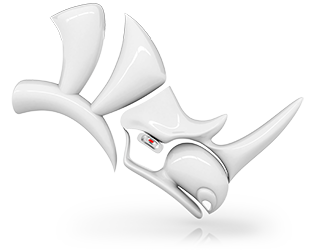Rhino offers aids to organize your work. Each method offers a different approach to model organization. These include:
- Layers let you assign a layer designation to objects.
- Groups associate objects so they can be selected as one.
- Blocks let you store and update an association of objects.
- Worksessions let you work on a part of a project while using other models in the project as references.
- Layers let you assign a layer designation to objects.
- Groups associate objects so they can be selected as one.
- Blocks let you store and update an association of objects.
 Layers
Layers
 Layers
Layers
Layers are a way of grouping objects and applying certain characteristics to all objects that have that layer assignment.
Layer states include a layer name, the color used to display the objects, and the on/off and locked/unlocked status of all the objects on a layer. Objects are always created on the current layer. This layer assignment can be changed later. Objects on layers that are off are not visible in the model. Objects on locked layers cannot be selected but can be snapped to.
Popup layer list
The popup layer list is a shortcut for the most common tasks related to layers.
To open the popup layer list
-
In the status bar, click the Layer pane.
-
When no object is selected, the layer pane displays the current layer.
-
When objects on the same layer are selected, the layer pane displays their layer.
-
When objects across layers are selected, the layer pane display “Varies”.
-
In the top panel, click the Layer pane.
-
The layer pane displays the current layer.


Popup layer list.
In the Popup layer list you can:
![]()
![]() Change the on/off state
Change the on/off state
![]()
![]() Change the locked/unlocked state
Change the locked/unlocked state
![]() Change the layer color
Change the layer color
![]()
![]() Set the current layer
Set the current layer
![]() Name or rename the layer
Name or rename the layer
In addition, right-click a layer name to perform these actions:
- Select objects on that layer
- Change selected objects to that layer
- Copy objects to that layer
Layers panel
Use the Layers panel for more detailed layer management.
To open the Layers panel
-
In the status bar, right-click the Layer pane.
In the lower section of the right sidebar, click the Layers panel icon.
 .
.
 .
.
In the Layers panel, in addition to the actions you can perform in the Popup layer list, you can also:
-
Create new layers and sublayers
-
Delete layers
-
Move layers up or down in the layer list
-
Elevate a sublayer
-
Filter the layer list
-
Set the layer render material
-
Set the layer linetype
-
Set the layer print color
-
Set the layer print width
Right-click in the Layers panel to display a menu offering additional layer functions.


![]() Click the Help icon in the toolbar to open the Help topic for the Layer command.
Click the Help icon in the toolbar to open the Help topic for the Layer command.
Review the Help topic for the Layers panel in Rhino Help.
 Groups
Groups
The Group command creates a virtual container for objects that can be selected as a single object to move, copy, rotate, or apply properties (e.g., object color). A group can include other groups. The Ungroup command destroys the top-level group.
For more information about groups, open the Help topic for the Group command.
 Blocks
Blocks
A block is another way of associating various objects together to form a single object. The Block command creates a block definition in the model’s database. Using a block definition uses less memory than using groups.
When you edit the block definition, all instances of the block are changed to match the new definition. Blocks streamline modeling, reduce the model size, and promote standardization of parts and details. Block definitions can be stored outside the model using linked blocks.
Exploding a block instance places the block geometry using the instance location, scale, and rotation.
The Insert command places instances of a block definition in your model. The instance refers to the block definition in the database.
You can scale, copy, rotate, array, and otherwise transform block instances in the model.
To edit geometry in a block definition, double-click a block instance, or use the BlockEdit command.
The BlockManager command displays a dialog box that lists all the block definitions in the model. Use the Block Manager dialog box to view block properties, export a block definition to a file, delete a block definition and all its instances, update a block definition from a file, find out what blocks are nested in other blocks, and count the number of block instances in the model.
 Worksessions
Worksessions
The Worksession command lets many users work on a large project by managing many files. Each user can edit a different file in the project and at the same time see the related portions of the project. Only one user can have a file open for editing, but many users can see it. By refreshing as needed, each user can see the current version of the related files in the projects.
Rhino worksessions let you attach external files to your current work environment. Attached geometry cannot be edited (Move, Scale), but it can be used for input to creation commands (Copy, ExtrudeCrv).
Rhinoceros 6 for Windows © 2010-2018 Robert McNeel & Associates. 03-Apr-2020
Rhino for Mac © 2010-2018 Robert McNeel & Associates. 03-Apr-2020

